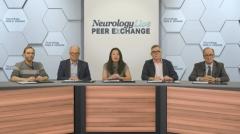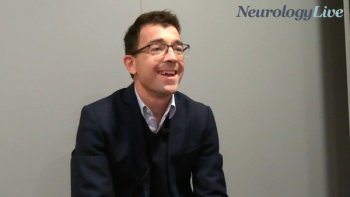
BTKi Effect on Chronic Active Lesions
Neurology experts discuss the potential effects of BTKi on chronic active lesions during multiple sclerosis therapies.
Episodes in this series

Gavin Giovannoni, MBBCh, PhD, FCP, FRCP, FRCPath: As the MRI expert, how do you interpret the results that came out in terms of either evobrutinib and its effect on slowly expanding lesions, for example?
Jiwon Oh, MD, PhD, FRCPC: I think we need to keep in mind that we don't yet know exactly how to use SELs when we're thinking about whether there is an effect of an agent on chronic active lesions. So just to summarize quickly for our audience, SELs stands for slowing expanding or evolving lesions. And this is an imaging measure that we think captures, at least in part, chronic active lesions, which are a major driver of CNS compartmentalized disease biology. And the way this is done is the beauty of it is you can actually use regular 1.5 Tesla MRI scanners. You just need a T1 and a T2 base sequence. And when an individual is scanned multiple times over time, you overlay the scans on top of each other, and when there is an existing lesion and the lesion slowly expands in a concentric fashion, that's what the algorithm detects as a SEL.
As you can imagine, probably some of the SELs that are being detected are not actually chronic active lesions, but some of the SELs probably are. And this is a measure that actually can be applied widely in clinical trials because many clinical trial centers have 1.5 Tesla MRIs, and all of the MRIs that are collected as part of phase 2 and phase 3 clinical trials include basic sequences like the T1 base sequence and T2 sequences.
This was a measure that was evaluated in the evobrutinib phase 2 clinical trial, and at 48 weeks, what was found was that the volume of SELs was lowest in the highest dose of evobrutinib compared to the lowest dose of evobrutinib that had been on placebo for the first 24 weeks. This was over a year when you look at the SEL volume—the highest dose of evobrutinib has the smallest SEL volume. What does this tell us? Well, I mean, you know, it's intriguing because could it be that higher doses of evobrutinib have reduced the volume of chronic active lesions? It's possible, but at the same time, you have to think that could it be that in this phase 2 clinical trial, the highest dose of evobrutinib arm already had the lowest volume of lesions to begin with? Because if you have a low volume of lesions at the end when you're evaluating for slowly expanding lesions, you may just have the smallest volume of SELs.
There's challenges with the SEL measure, but the SEL measure is interesting, and I think the SEL measure needs to be confirmed in larger clinical trials. And is there any PET data, you know, using TSPO for hot microglia? I think PET imaging with TSPO is being evaluated in small subsets in the phase 3 development program, but in the phase 2 programs of either evobrutinib or tolebrutinib, there is no PET data as of yet that I'm aware of.
Amit Bar-Or, MD, FRCPC: Can I ask another imaging measure that is thought to capture at least some of the chronic active lesions or the paramagnetic rim lesions and that in particular in the context of BTK inhibition is that those paramagnetic rim lesions are thought to be iron-laden microglia that are perhaps at the advancing edge of the ongoing injury and would be a putative target of BTK inhibition within the CNS? Anything that we've learned from the experience to date, particularly the tolebrutinib trial with respect to PRLs, paramagnetic rim lesions?
Jiwon Oh, MD, PhD, FRCPC: Similar to SELs, I think PRLs are intriguing, and one could argue that because paramagnetic rim lesions are detecting a rim of iron, PRLs may be a bit more specific to detecting chronic active lesions, but again we don't know this for sure. So the issue with paramagnetic rim lesions is you typically do need a 3 Tesla scanner, and there's not yet consensus in the field about what sequence is best to detect these paramagnetic rim lesions. But in the tolebrutinib phase 2 trial, there were 32 or so patients that did have PRLs evaluated at baseline and over time. Of the 129 patients in the trial, it’s really only a quarter of the patients, so obviously very small numbers, but at least at the 96 week point when PRLs were evaluated, the vast majority of people, the PRLs that they had at baseline were still there at 96 weeks, but there were a few people where the PRLs disappeared and then there were also a few people where they developed new PRLs.
And so how this relates to different doses of tolebrutinib when people started on the highest dose of tolebrutinib, that all remains to be determined, but it's interesting, small numbers. I don't think we can draw any conclusions from the PRL data, but and the other thing is it's clear that PRLs don't change very quickly. And so whether PRLs can be reliably used as an endpoint in the typical duration of clinical trials that we have, I'm not sure, but it's possible that it may not necessarily be appearance or disappearance of PRLs we need to focus on. It might be we need to measure something around PRLs, so that may make it possible to use these measures. It's not as easy as we had hoped, but again, the phase 3 clinical trials are including measurement of PRLs in many sites, so hopefully we'll have more PRL data so that we can figure out how to use these measures in the years to come.
Gavin Giovannoni, MBBCh, PhD, FCP, FRCP, FRCPath: Well, coming back to tolebrutinib, at ECTRIMS, there was the CSF study using O-link proteomic analysis from NIH, and it fits with your opinion—the tolebrutinib CSF study, the myeloid signal on the proteome is definitely downregulated. So I'm feeling pretty confident that these drugs are getting into the CNS and are impacting on the myeloid component, you know, at least a hint on MRI, but a much better data coming out on CSF analysis.
Krzysztof Selmaj, MD, PhD: Actually I would follow on your suggestion that since we are saying that these drugs might contribute to myeloid repair, and even through remyelination, do we have any or will we have an MRI data which might support these suggestions, like MTR or some diffusion tensor studies?
Jiwon Oh, MD, PhD, FRCPC: There are not these advanced MRI measures at all sites, but again at many sites in the phase 3 clinical development program, a number of more advanced imaging measures that have been included as exploratory endpoints which include MTR, so hopefully we'll be able to analyze some of these advanced MRI measures and look at the right area that will allow us to draw some conclusions. And I agree with Gavin. I think some of the CSF data that's coming forward, really interesting, and does help to paint a fulsome picture of what may be happening, but in the end the proof will always be in the phase 3 clinical trial data.
TRANSCRIPT EDITED FOR CLARITY
Newsletter
Keep your finger on the pulse of neurology—subscribe to NeurologyLive for expert interviews, new data, and breakthrough treatment updates.










































